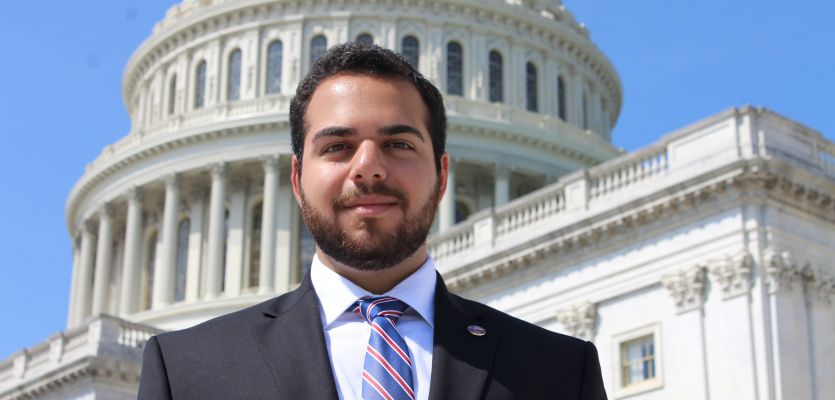ANCA x h-pem | Bringing Armenia’s religious heritage to the American capital
September 06, 2018
From vishapakars (dragon stones) to khachkars (cross-stones), the Armenian people’s fascination with carving beautifully intricate designs in stone is one of our most defining cultural and artistic legacies. Armenian National Committee of America (ANCA) intern, Christopher Khachadour, takes a stroll around sculptor Bogdan Hovhannisyan’s booth at the Smithsonian Folklife Festival, to learn more about this ancient craft and the importance of safeguarding it for future generations.
Armenia is a rocky piece of the earth
These plentiful rocks have been used by the Armenian nation to tell our stories. We mastered the art of dressing stones to cater to our needs. In pre-Christian Armenia, the vishapakars (dragon stones) were erected near water sources and served as the defenders of treasures. Only 150 or so vishapakars remain, 90 of which are found in today’s Republic of Armenia. With the conversion of the Kingdom of Armenia in the early 4th century came the emergence of the khachkar (cross-stone). Many vishapakars were subsequently converted into khachkars, which are memorials for people, military victories, church constructions, and other major events. Today 50,000 or so remain, with most located near churches or in graveyards in the Republic of Armenia and Artsakh, and those in Turkey, Azerbaijan, and Georgia largely destroyed. In 2010, the khachkar was inscribed in UNESCO’s Intangible Cultural Heritage List.
The Smithsonian Folklife Festival of 2018 showcased the cultural heritage of Armenia. Among the most eye-catching exhibits were the khachkar carvers. The master, Bogdan Hovhannisyan, and his apprentice, Gayane Manucharyan, were creating their own pieces: Bogdan, a large black tufa khachkar, and Gayane, a red tufa sundial. Bogdan would work for a second and then lift his head up to speak with onlookers, switching from Armenian to English, and from speaking to singing. He spoke with a melodic voice and would burst into song with the slightest inclination.
Born and raised in Vanadzor—Armenia’s third largest city—Bogdan had initially planned to become a painter, but while enrolling in the fine arts college, he mistakenly applied for the sculpture class. By profession, he is a sculptor, but for the last 30 years, he has been carving khachkars. Every khachkar is unique, but Bogdan claims his are extra unique. To date, he’s carved 15 types and combines the various colors of the tufa stone that Armenia is known for, such as black, red-orange, and pink.
While speaking with Bogdan and listening to him describe the art of khachkar carving, I could not help but remember the destruction of the cemetery of Julfa in Nakhichevan. Said to be founded over 2,000 years ago by an Armenian king, Julfa rose to prominence in the 15-17th centuries as a major player on the Silk Road. With the forced removal of Armenians in 1604 by Shah Abbas I Safavi, Julfa became a ghost town and its cemetery remained abandoned. The people of Julfa were taken to Isfahan, the Imperial Capital, and resettled in New Julfa.
Standing as a testimony to the rich history of the city, the cemetery contained 10,000 tombstones—most of them, khachkars. After several periods of attempted destruction, in 2006, an Azerbaijani Armed Forces shooting range was built over it. Fewer than a dozen of the khachkars from Julfa remain, with most located in the courtyard of the Mother See of Holy Etchmiadzin and a few resting in museums around the world.
From Vanadzor to Pasadena, 10 million strong
While talking with Bogdan, he asked me where I’m from. I was born in Pasadena, California, but my great-grandparents were from Aintab and Urfa. It turns out that his native city, Vanadzor, and my native city, Pasadena, are sister cities. He was very ecstatic to hear this and expressed how he would love to come to Pasadena for a sister-city event and talk about the art of khachkar carving and give younger schoolchildren classes on Armenian miniature painting. He gave me a card with his number, address, and Facebook profile to keep in contact. In the near future, I hope to see Bogdan at a sister-city event in my hometown.
Thinking about Julfa and hearing Bogdan’s stories on preserving the ancient and meticulous art of khachkar carving reminded me of the importance of preserving the ways of our ancestors. This preservation is not limited to these cross-shaped stones, but also includes our history, cuisine, dances, and most importantly, language.
It was only 100 years ago that the Ottoman Turks tried to erase our nation from the pages of history, but in these past two weeks, I saw the best of our cultural heritage showcased to millions of people at the National Mall, in the heart of the U.S.’s formidable capital. Seeing non-Armenians and Armenians alike engage with the stone-carvers, woodcarvers, carpet weavers, cooks, storytellers, and dancers allowed me to, once again, appreciate the richness that comes with being Armenian. It is not a right to claim lineage from such a proud and creative nation, but a privilege to be a part of this now-globalized family of 10 million.
Any additional references or recommendations? We would love to hear your suggestions!
Join our community and receive regular updates!
Join now!



Attention!